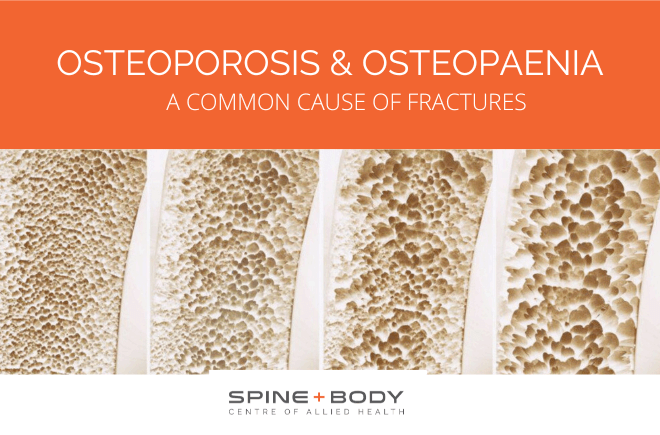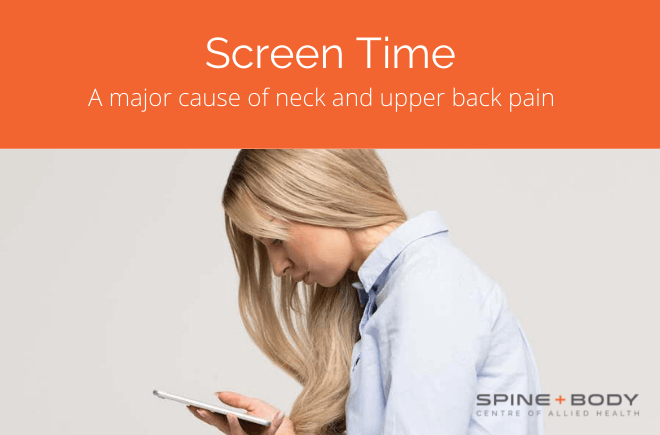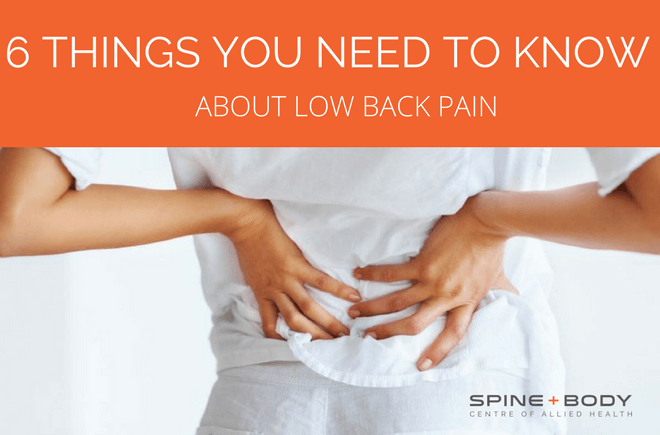Osteoporosis – a common cause of fractures

By Peter Georgilopoulos, APA Sports Physiotherapist, Spine + Body Gold Coast.
Osteoporosis, and its precursor Osteopaenia, are the silent infiltrators that erode bone density and strength and commonly cause age related postural degradation. The loss of bone matrix contributes to a stooped posture and limb fractures [especially of the hip and wrist], pain in the weight bearing joints, receding gums and poor prehensile strength. The term Osteoporosis literally comes from the Greek word for bone [osta] and “porosis” which means to be infiltrated with holes or to have a porous consistency.
Normal cortical bone displays great density within its outer calcium matrix bestowing linear and weight bearing strength to the long bones of the lower and upper limbs. In areas such as the pelvis and the vertebrae, a different type of bone known as cancellous bone is able to distribute force across wide and dense structural weight-bearing regions without unnecessary weight. Cancellous bone is both strong and light because of the interconnecting tiny chambers of bone within a solid exterior. This may be confusing as this is precisely how osteoporotic bone is generally described – a bone infiltrated with holes. In cancellous bone however, the interconnected cavities are supported by dense bone able to withstand and disperse great impact force. In Osteoporotic or Osteopaenic bone, the calcium matrix is depleted thereby elevating the likelihood of early deterioration or fracture.
Osteoporosis describes the severe form of this condition whilst Ostepaenia is the precursor which describes the early signs of calcium depletion. Osteopaenia can progress to osteoporosis if left untreated but both can be reversed to some extent if tackled with appropriate medical and exercise driven interventions. Diagnosis is made through bone density tests ordered by your medical practitioner providing an accurate measure of the calcium status of various body sites, in particular the high risk regions such as the hips, pelvis and spine. Interestingly, varying degrees of depletion may appear in different body regions which will be highlighted in the final analysis. In other words, the degree of calcium depletion may not be uniformly distributed throughout the entire body but may be centered on specific sites throughout life, which can alter as the process infiltrates new areas.
Typical sequelae are early joint degenerative changes [osteoarthritis], malformation of vertebrae into wedge rather than rectangular shaped configurations, flattening of the actual vertebral body thereby resulting in progressive shortening of stature in later life and higher risk of limb fractures as a result of minimal impact force. There is often a progressive loss of function due to joint deformity and pain as the protective layer of cartilage is worn away exposing pain sensitive bone. Further to that, reduced functional capacity often results in inactivity linked to elevated cardiovascular risk factors. Any fractures, such as the neck of the femur, may pose dire consequences as prosthetic hip joints may not be feasibly undertaken as the existing bone is insufficiently strong enough to withstand the implant.
What are the causes of Osteopaenia?
There are many possible causes for the onset of osteopaenia and consequent osteoporosis. Disuse atrophy can affect all ages, especially in situations in which weight bearing and resistance training cannot be undertaken such as during prolonged periods of enforced bed rest due to sickness or injury. Astronauts and those living for extended periods in space will experience bone density depletion simply by being in a zero gravity environment. Most commonly, these conditions may be linked to post- menopausal women in which the depletion of female hormones is linked to an impaired ability to bind calcium. A lack of vitamin D or avoidance of the sun may also significantly contribute to poor bone health. Although excessive exposure to sunlight presents well documented risk factors, an under exposure to sunlight can also lead to rickets, osteopaenia or osteoporosis. Even in maximum security facilities, prisoners are allowed to exercise in sunlight for a short period daily for this very reason. Genetics may also play a role with some inheriting a higher predisposition to these conditions than others. Poor lifestyle choices such as alcohol and smoking also appear to be significant contributors. A hypothesis for why this may be the case, may be related to the deterioration of the peripheral vascular system from both smoking and drinking thereby reducing blood flow to the extremities which in turn may have a depleting effect on bone density as well as all other tissues.
How can I prevent Osteopaenia?
Perhaps the greatest contributors are lack of exercise and a calcium poor diet. The good news is that by undertaking measures to reverse as many of these undesirable contributing factors, bone density can be progressively restored in many cases. A sensible approach may be to cease smoking, reduce or eliminate alcohol consumption, undertake weight bearing and resistance type exercise, align with improved dietary practices including foods high in calcium and seek to spend some time daily in daylight [not necessarily direct sunlight].
In some cases, your doctor may prescribe specific medications that can help to reverse poor bone density. These can be highly effective especially when combined with progressive resistance exercise and vitamin D. It is advisable not self- medicate with calcium supplementation as unregulated intake can adversely affect cardiac function and other body systems. Early interventions such as bone density studies and medical advice in regards to medications and supplementation can bolster the beneficial lifestyle changes mentioned previously to help restore and maintain good skeletal health throughout life.
 Book your appointment with Peter Georgilopoulos at Spine + Body.
Book your appointment with Peter Georgilopoulos at Spine + Body.Peter is Director and Founder of Spine + Body Centre of Allied Health on the Gold Coast ph: 07 5531 6422




